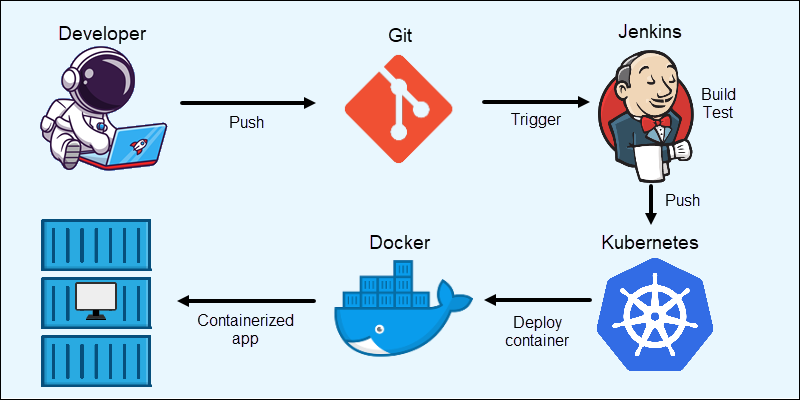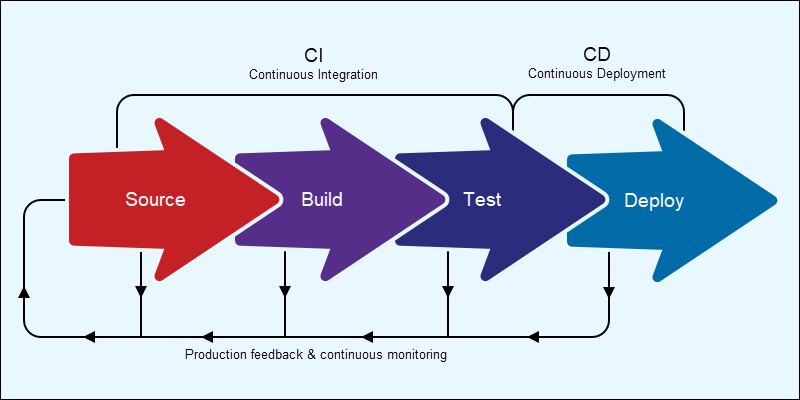By automating operational procedures in the software development lifecycle, fault discovery occurs early, productivity increases and delivery to end-users is faster. As a result of automating the operational procedures within the software development cycle, the team can push out stable software updates much more frequently and create a DevOps workflow. CI/CD is the reason software updates happen quickly and efficiently.
This post provides an overview of the main concepts and elements in the CI/CD pipeline.
What Is a CI/CD Pipeline?
The CI/CD pipeline is the continuous integration, delivery, and deployment workflow. The pipeline focuses on CI/CD tools. On the other hand, a DevOps pipeline focuses more on responsiveness, highlighting the importance of input from different DevOps roles and responsibilities.
The ideal combination of DevOps principles and pipeline automation creates an environment for continual software delivery.
Stages of the CI/CD Pipeline
The CI/CD pipeline goes through the necessary steps before delivery for each software change. The pipeline is divided into four stages. If one of the stages fails, a notification will be sent to the entire team. Each stage has a specific purpose to ensure consistency, quality and speed. Depending on the project, an organization can add more steps.
1. Source
Development teams use version control systems, such as Git. These systems store the code in a central repository. Tracking changes, collaborating and securing source code is a breeze.
CI assumes that repository changes occur at least daily if not even more frequently. Source tracking is the first step of the pipeline automation. Monitoring changes and triggering events based on actions provides better control over the source code.
Automating the source ensures the team stays informed of any changes and problems with the code. By identifying the problem and alerting the team, developers can act quickly to resolve the issue. Build
The stage of building combines source code and dependencies. The result is an instance of the software potentially ready for end-users.
This step includes compiling code for languages like Go or Java. This action will require special build tools like Maven, Ant or Gradle. These tools are not required for interpretive languages like Python or Ruby. Test
The pipeline’s testing stage involves an enormous amount of automation. Continuous testing is used to ensure that pipelines are able to detect issues even during development. This process is made easier by a variety of automation testing tools.
The test runs across multiple devices and environments. The earlier you start, the better. Performance, integration, functionality, and regression testing are automated during the testing stage. Using both white box and black box testing yields the best results.
Discovering bugs as quickly as possible brings two benefits:
1. The issues do not reach the end-user, resulting in improvement in user experience.
2. It is easier for developers to fix bugs when the code is fresh. Debugging is less expensive when issues are addressed as soon as possible.
3. Deploy
Deployment is the final step in CI/CD. There are many ways to deploy software, including assessing a few nodes or providing software versions. Various deployment strategies exist, including assessing a few nodes or providing software versions.
The key aspects to consider automating during the deployment stage are:
Deployment and code migration security through container orchestration tools such as Kubernetes or Docker Swarm.
Configuration file and permission management through tools such as Puppet or Chef.
Template infrastructure creation and management between environments through IaC provisioning tools such as Terraform.
CI/CD Pipeline Example
A CI/CD pipeline consists of many programs and components. The components and steps differ depending on the use case.
Below is an example pipeline for deploying a Kubernetes cluster:
Multiple developers connect to a version control system, such as Git. Each update and change to the source code triggers a CI/CD action and starts the pipeline process. The tool also runs tests on the software. Once all the trials and verifications pass, the integration system pushes the created image into a Kubernetes cluster.
- The Kubernetes cluster prepares and deploys Docker containers for the software build.
- Lastly, Docker containerizes the software and ships the components for integration.
- The above example demonstrates the complex process behind the pipeline. The developers are notified immediately if any step fails. Enhance the pipeline further by adding CI/CD pipeline security and monitoring throughout the different stages to create a DevSecOps environment.
Important CI/CD Pipeline KPIs
A faulty implementation of a CI/CD pipeline hinders the development process and slows the whole team down. To see whether the implemented pipeline strategy performs well, consider the following key performance indicators (KPIs):

- Code quality. Code quality can be quantified using static code analysis tools, IDE plugins and other IDE plug-ins. The development standard is improved by tracking the quality, which reduces the number of build failures. Before pushing code, developers test and debug their work.
- Cycle time. How long does the entire production cycle take? The cycle time estimates the amount of time it takes to get an idea from conception to end-user.
- Lead time to deployment. How long will it take before the code is ready for production? Many organizations are hindered by the bottleneck that exists between writing code and delivering it. Compared to cycle time, lead time to deploy does not account for the time taken to write the code and focuses solely on the pipeline efficiency.
- Availability. The availability of the entire system is an operational metric, and knowing the uptime ensures the pipeline is stable and dependable.The list is not comprehensive. For other metrics, check out our extensive list of DevOps KPI metrics.
CI/CD Pipeline ToolsVarious tools help automate parts of the CI/CD pipeline. Below is a brief list of CI/CD tools.
Version Control
Git is a widely used software for tracking changes and collaborative development.Subversion
is the less popular Apache alternative. The system has a wide application in the open-source community.
Build Tools
Maven
is a build automation tool for Java projects. Maven is compatible with other languages such as C# and Scala.
Ant
is a Java library for automating build processes and dependencies using XML files.
Gradle
- is a build automation tool for development tasks, compilation, and test preparation. Supports languages such as Java, JavaScript, C/C++, and others.CI/CD Server Tools
- Jenkins is an automation server with hundreds of plugins for automating CI/CD tasks.
Bamboo
- is a CI/CD pipeline server for software release management and automation.
- TeamCity
- is a build-management and automation server with native integration for various Java IDEs.CI/CD Pipeline Best Practices
- Implementing a CI/CD pipeline takes a lot of work and practice. There is no one solution that fits all. Each solution is different. Consider the following tips to set up a CI/CD pipeline successfully:Analyze the current environment and the steps taken to develop software. Pay attention to repetitive tasks and which steps in the cycle can be automated.
Define the success metrics before building the pipeline. Metrics provide a quantifiable way to analyze the CI/CD functionality.
- Start with a smaller project and provide a proof of concept to demonstrate the CI/CD pipeline functions and solves problems.Set up the pipeline process into multiple stages. Assessment of each smaller section will ensure faster feedback.
- Run the workflows in a clean environment for consistency.
Peer review each pull request to increase collaboration and dependability. - ConclusionThe CI/CD pipeline has unique challenges. It takes time to set up different automation software. Consider adopting CI/CD practices. Once the environment is working, the benefits outweigh any disadvantages.
